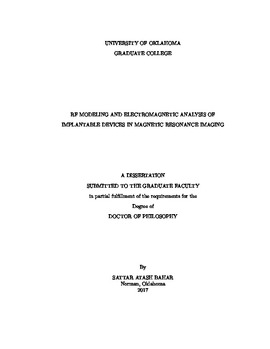| dc.description.abstract | Magnetic Resonance Imaging (MRI) has become a generally accepted medical procedure and it is estimated that all the U.S. population will have at least one MRI scan in their lifetime. Unlike common radiography and computed tomography, MRI has many advantages including its nonionizing nature and the capability to distinguish soft tissues. However, the substantial benefits of MRI are often not available to patients with implanted medical devices, such as a pacemaker, an implantable cardiovascular device, a deep brain stimulator, or a neurostimulator.
MRIs utilize three powerful fields in the process of producing images, static field, gradient field and Radio Frequency (RF) field that coexist during the scanning. The interaction between the implantable device and the RF electromagnetic field is the main hazard during MRI scanning for most active implantable medical devices. The conductive parts, mainly, the lead wire, act like antennas that pick up the available incident energy. This may result in excessive heating with the capacity for tissue damage \cite{nordbeck2008spatial, mccabe2014cause}. Moreover, the RF power delivered to the Implantable Pulse Generator (IPG) is another concern as it can damage the internal circuitry \cite{mo2016study, armenean2004rf}.
In this research, a comprehensive model of the implant in the presence of MRI RF waves is presented. This circuit model represents the induced current and is used to design a lead that minimizes the coupled power to the IPG. This model significantly simplifies designing a new lead by removing Electromagnetic (EM) simulation of implantable devices inside the human body. Also, a circuit model is introduced that extracts the transfer function from the measured parameters of the lead. A miniaturized RF power measurement setup that conforms to the IPG case is designed and used to measure the coupled RF power to the IPG without using external components. This method of measurement, improves the accuracy of the measurement and can be used to measure RF coupled power to the antenna. For communication to the implant using Bluetooth technology, an antenna is designed and the effectiveness of the new measurement setup for the coupled MRI RF waves to the antenna port is demonstrated. | en_US |
